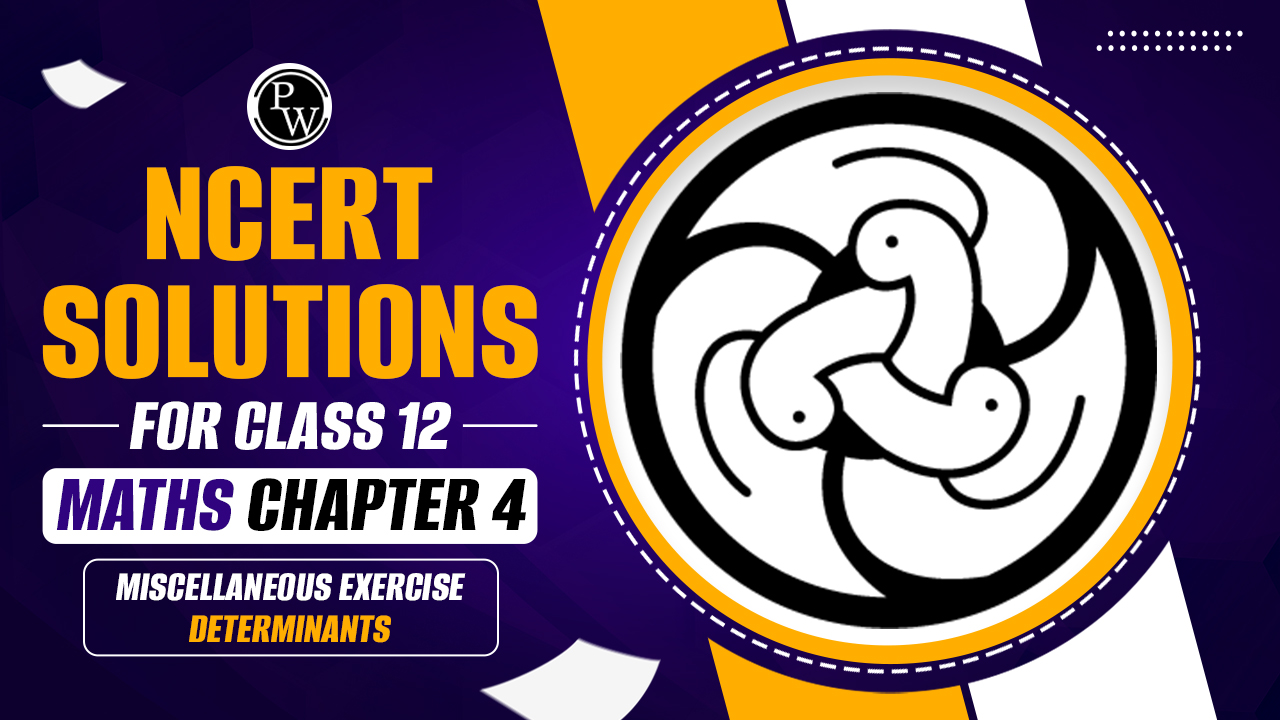NCERT Solutions for Class 12 Maths Chapter 4 Miscellaneous Exercise Determinants

Class 12 Maths Chapter 4 Miscellaneous Exercise Determinants:- In Chapter 4 of Class 12 Mathematics, we explore the concept of determinants, a key topic in algebra. Determinants help solve systems of linear equations, find the inverse of a matrix, and understand linear transformations. The Miscellaneous Exercise in this chapter includes a variety of problems that test your understanding and ability to apply the properties and uses of determinants. These exercises aim to strengthen your problem-solving skills and prepare you for more advanced mathematical concepts and real-world applications. Get NCERT Solutions for Class 12 Maths Chapter 4 Miscellaneous Exercise Determinants below.
Check out: CBSE Class 12th Books
NCERT Solutions for Class 12 Maths Chapter 4 Miscellaneous Exercise Determinants
Here are NCERT Solutions for Class 12 Maths Chapter 4 Miscellaneous Exercise Determinants below:-
Question 1. Prove that the determinant is independent of θ.
Solution :
Hence, Δ is independent of θ.
Question 2. Without expanding the determinants, prove that:
Solution :
Question 3. Evaluate:
Solution :
Question 4. If a,b and c are real numbers and
Show that either a + b + c = 0 or a = b = c.
Solution :
Question 5. Solve the equation:
Solution :
Check out: Class 12th Sample Papers
Question 6. Prove that:
Solution :
Question 7. If
Solution :
Question 8.
Solution :
Question 9. Evaluate:
Solution :
Question 10. Evaluate:
Solution :
Check out: Class 12th Question Banks
Using properties of determinants in Exercises 11 to 15, prove that:
Question 11.
Solution :
Question 12.
Solution :
Question 13.
Solution :
Question 14.
Solution :
Question 15.
Solution :
Question 16. Solve the system of the following equations: (Using matrices):
Solution :
Choose the correct answer in Exercise 17 to 19.
Question 17. If a,b,c are in A.P., then the determinant is:
(A) 0
(B) 1
(C) x
(D) 2x
Solution :
Here, all the elements of the first row (R1) are zero.
Hence, we have Δ = 0.
The correct answer is A.
Question 18. If x,y,z are non-zero real numbers, then the inverse of matrix A = is:
(A)
(B)
(C)
(D)
Solution :
Therefore, option (A) is correct.
Question 19. Let where 0 ≤ θ≤ 2π, Then:
(A) Det (A) = 0
B. Det (A) ∈ (2, ∞)
C. Det (A) ∈ (2, 4)
D. Det (A)∈ [2, 4]
Solution :
Therefore, option (D) is correct.
Check out: Class 12 Mathematics Question & Concept Bank
Class 12 Maths Chapter 4 Miscellaneous Exercise Determinants Summary
The Miscellaneous Exercise in Chapter 4 of Class 12 Mathematics focuses on determinants. This exercise includes a wide range of problems that test your understanding of the properties and applications of determinants. Here is a summary of what you will encounter:
-
Basic Properties: Questions involving the basic properties of determinants, such as linearity, the effect of row and column operations, and the impact of swapping rows or columns.
-
Calculations: Problems that require calculating the determinant of matrices of various sizes, often involving multiple steps and properties to simplify the process.
-
Adjoint and Inverse: Exercises that involve finding the adjoint and inverse of a matrix using determinants, reinforcing the connection between these concepts.
-
Systems of Equations: Questions that use determinants to solve systems of linear equations, typically applying Cramer's rule or other determinant-based methods.
-
Applications: Real-world applications of determinants, such as finding the area of triangles using vertices' coordinates or understanding linear transformations.
Class 12 Maths Chapter 4 Miscellaneous Exercise Determinants FAQs
Q1. What are some properties of determinants?
Ans. Key properties include:
-
The determinant of a product of matrices is the product of their determinants.
-
Swapping two rows or columns changes the sign of the determinant.
-
If a row or column is multiplied by a scalar, the determinant is multiplied by that scalar.
-
A matrix with two identical rows or columns has a determinant of zero.
How do row and column operations affect the determinant?
Ans. Row and column operations can simplify the calculation of determinants. However, you need to adjust the determinant accordingly (e.g., swapping rows changes the sign).
What is Cramer's Rule?
Ans. Cramer's Rule is a method for solving systems of linear equations using determinants. Each variable is found by dividing the determinant of a matrix with one column replaced by the constants by the determinant of the coefficient matrix.
How do you find the inverse of a matrix using determinants?
Ans. The inverse of a matrix AAA can be found if det(A)≠0\det(A) \neq 0det(A)=0. It is given by A−1=1det(A)⋅adj(A)A^{-1} = \frac{1}{\det(A)} \cdot \text{adj}(A)A−1=det(A)1⋅adj(A), where adj(A)\text{adj}(A)adj(A) is the adjugate of AAA.
What are some real-world applications of determinants?
Ans. Determinants are used in various fields such as physics, engineering, computer graphics, and economics. For example, they can be used to calculate the area of a triangle given its vertices' coordinates.
How do you find the adjoint of a matrix?
-
The adjoint of a matrix is the transpose of its cofactor matrix. Each element of the cofactor matrix is the determinant of the submatrix obtained by deleting the corresponding row and column, multiplied by (−1)i+j(-1)^{i+j}(−1)i+j.









